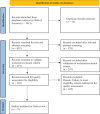An adaptive data-driven architecture for mental health care applications
- PMID: 38563009
- PMCID: PMC10984189
- DOI: 10.7717/peerj.17133
An adaptive data-driven architecture for mental health care applications
Abstract
Background: In the current era of rapid technological innovation, our lives are becoming more closely intertwined with digital systems. Consequently, every human action generates a valuable repository of digital data. In this context, data-driven architectures are pivotal for organizing, manipulating, and presenting data to facilitate positive computing through ensemble machine learning models. Moreover, the COVID-19 pandemic underscored a substantial need for a flexible mental health care architecture. This architecture, inclusive of machine learning predictive models, has the potential to benefit a larger population by identifying individuals at a heightened risk of developing various mental disorders.
Objective: Therefore, this research aims to create a flexible mental health care architecture that leverages data-driven methodologies and ensemble machine learning models. The objective is to proficiently structure, process, and present data for positive computing. The adaptive data-driven architecture facilitates customized interventions for diverse mental disorders, fostering positive computing. Consequently, improved mental health care outcomes and enhanced accessibility for individuals with varied mental health conditions are anticipated.
Method: Following the Preferred Reporting Items for Systematic Reviews and Meta-Analyses guidelines, the researchers conducted a systematic literature review in databases indexed in Web of Science to identify the existing strengths and limitations of software architecture relevant to our adaptive design. The systematic review was registered in PROSPERO (CRD42023444661). Additionally, a mapping process was employed to derive essential paradigms serving as the foundation for the research architectural design. To validate the architecture based on its features, professional experts utilized a Likert scale.
Results: Through the review, the authors identified six fundamental paradigms crucial for designing architecture. Leveraging these paradigms, the authors crafted an adaptive data-driven architecture, subsequently validated by professional experts. The validation resulted in a mean score exceeding four for each evaluated feature, confirming the architecture's effectiveness. To further assess the architecture's practical application, a prototype architecture for predicting pandemic anxiety was developed.
Keywords: Anxiety prediction; Big data; Data-driven architectures; Health care; Machine learning algorithms; Mental health.
© 2024 Sundaram et al.
Conflict of interest statement
The authors declare that they have no competing interests.
Figures
Similar articles
-
Service design for children and young people with common mental health problems: literature review, service mapping and collective case study.Health Soc Care Deliv Res. 2024 May;12(13):1-181. doi: 10.3310/DKRT6293. Health Soc Care Deliv Res. 2024. PMID: 38767587 Review.
-
Impact of COVID-19 and other pandemics and epidemics on people with pre-existing mental disorders: a systematic review protocol and suggestions for clinical care.BMJ Open. 2020 Sep 1;10(9):e040229. doi: 10.1136/bmjopen-2020-040229. BMJ Open. 2020. PMID: 32873685 Free PMC article.
-
The future of Cochrane Neonatal.Early Hum Dev. 2020 Nov;150:105191. doi: 10.1016/j.earlhumdev.2020.105191. Epub 2020 Sep 12. Early Hum Dev. 2020. PMID: 33036834
-
A Reference Architecture for Data-Driven and Adaptive Internet-Delivered Psychological Treatment Systems: Software Architecture Development and Validation Study.JMIR Hum Factors. 2022 Jun 20;9(2):e31029. doi: 10.2196/31029. JMIR Hum Factors. 2022. PMID: 35723905 Free PMC article.
-
Ubiquitous and smart healthcare monitoring frameworks based on machine learning: A comprehensive review.Artif Intell Med. 2022 Dec;134:102431. doi: 10.1016/j.artmed.2022.102431. Epub 2022 Oct 22. Artif Intell Med. 2022. PMID: 36462891 Free PMC article. Review.
References
-
- Aggarwal R, Girdhar N. Machine learning role in cognitive mental health analysis amid Covid-19 crisis: a critical study. 2022 International Conference on Machine Learning, Big Data, Cloud and Parallel Computing, COM-IT-CON 2022.2022.
-
- Ai J, Russomanno J, Guigou S, Allan R. A systematic review and qualitative assessment of fraud detection methodologies in health care. North American Actuarial Journal. 2022;26(1):1–26. doi: 10.1080/10920277.2021.1895843. - DOI
-
- Aldabbas H, Albashish D, Khatatneh K, Amin R. An architecture of IoT-aware healthcare smart system by leveraging machine learning. International Arab Journal of Information Technology. 2022;19(2):160–172. doi: 10.34028/iajit. - DOI
-
- Alharbi TS, Fkih F. Building and testing fine-grained dataset of COVID-19 tweets for worry prediction. International Journal of Advanced Computer Science and Applications. 2022;13(8):645–652. doi: 10.14569/IJACSA.2022.0130874. - DOI
Publication types
MeSH terms
LinkOut - more resources
Full Text Sources
Medical






